- Joined
- Oct 9, 2007
- Messages
- 47,300 (7.53/day)
- Location
- Hyderabad, India
| System Name | RBMK-1000 |
|---|---|
| Processor | AMD Ryzen 7 5700G |
| Motherboard | ASUS ROG Strix B450-E Gaming |
| Cooling | DeepCool Gammax L240 V2 |
| Memory | 2x 8GB G.Skill Sniper X |
| Video Card(s) | Palit GeForce RTX 2080 SUPER GameRock |
| Storage | Western Digital Black NVMe 512GB |
| Display(s) | BenQ 1440p 60 Hz 27-inch |
| Case | Corsair Carbide 100R |
| Audio Device(s) | ASUS SupremeFX S1220A |
| Power Supply | Cooler Master MWE Gold 650W |
| Mouse | ASUS ROG Strix Impact |
| Keyboard | Gamdias Hermes E2 |
| Software | Windows 11 Pro |
NVIDIA detailed the design of its GeForce RTX 4090 Founders Edition graphics card in a briefing with us today.
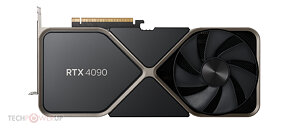

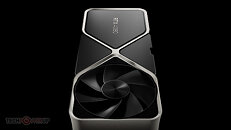
While the new Founders Edition looks very similar to the RTX 3090 Ti Founders Edition, NVIDIA says it has made several changes to its design. The metal outer frame now comes with a more pronounced gunmetal tinge. The heatsink array underneath has been redesigned to improve airflow between the two fans.
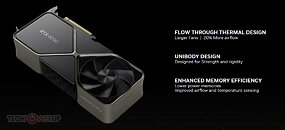

The fan itself has been updated, too. NVIDIA says it tested as many as 50 new fan designs before choosing this one, which offers up to 20% higher airflow than the one you have in the RTX 3090 Ti. Besides the heatsink and fan, the company also redesigned the vapor-chamber plate that pulls heat from the GPU and surrounding memory chips; as well as the base plate drawing heat from the VRM components. The heatpipes follow an improved heat-distribution.
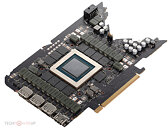
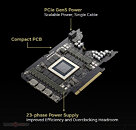
The card uses the same compact PCB design like the GeForce 30 Series and allows airflow through the card. RTX 4090 draws power from a single 12+4 pin PCIe Gen 5 ATX 12VHPWR connector that's capable of pulling up to 600 W of power over a single cable. NVIDIA made it clear the existing power supplies will work fine through the use of adapter cables, a ATX 3.0 PCI-Express 5.0 power supply is not required for Ada Lovelace GPUs.
While the RTX 4090 operates at 450 W by default, the power delivery capability allows you to increase the power limit up to 600 W for overclocking. The card features a 23-phase VRM (20-phase GPU + 3-phase memory). NVIDIA claims that it has re-architected its VRM to offer superior transient voltage management. This is specifically to minimize the kind of spikes or excursions we've seen with previous-gen high-end graphics cards such as the RTX 3090 Ti and Radeon RX 6900 Series. These spikes often causes spontaneous shutdowns on some power supplies, even if they had a much higher wattage rating than required.
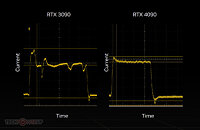
In the chart above, NVIDIA shows how current spikes get mitigated by their new VRM design, which uses a PID controller feedback loop. While the RTX 3090 bounces up and down, the RTX 4090 stays relatively stable, and just follows the general trend of the current loading pattern thanks to a 10x improvement in power management response time. It's also worth pointing out that the peak power current spike on the RTX 3090 is higher than the RTX 4090, even though the RTX 3090 is rated 100 W lower than the RTX 4090 (350 W vs 450 W).
This should come as big news for those with older PSUs that are counting on the in-box adapter that's bundled with every Founders Edition and that converts three 8-pin PCIe power connectors into the 12+4 pin ATX 12VHPWR connector; without having to wait for newer-generation ATX 3.0 + PCIe Gen 5 compliant PSUs. This however doesn't necessarily mean that custom-design graphics cards will meet the same transient-response standards.
A special focus was put on memory temperature, which has been decreased by 10°C. In collaboration with Micron, NVIDIA selected memory chips fabricated on a new process, and all chips are 16 Gbit (density), which means they all fit on the same side of the PCB, so they can be cooled more effectively.
The GeForce RTX 4080 16 GB Founders Edition shares the same cooler design as the RTX 4090, despite being a notch lower in positioning.



Just as reminder, GeForce RTX 4090 will be available on-shelf on October 12th, for $1600. NVIDIA's new flagship graphics card uses the 4 nanometer AD102 Ada Lovelace GPU and comes with 384-bit 24 GB GDDR6X memory from Micron. The number of GPU cores is 16384, with 512 TMUs and 192 ROPs.
View at TechPowerUp Main Site



While the new Founders Edition looks very similar to the RTX 3090 Ti Founders Edition, NVIDIA says it has made several changes to its design. The metal outer frame now comes with a more pronounced gunmetal tinge. The heatsink array underneath has been redesigned to improve airflow between the two fans.


The fan itself has been updated, too. NVIDIA says it tested as many as 50 new fan designs before choosing this one, which offers up to 20% higher airflow than the one you have in the RTX 3090 Ti. Besides the heatsink and fan, the company also redesigned the vapor-chamber plate that pulls heat from the GPU and surrounding memory chips; as well as the base plate drawing heat from the VRM components. The heatpipes follow an improved heat-distribution.


The card uses the same compact PCB design like the GeForce 30 Series and allows airflow through the card. RTX 4090 draws power from a single 12+4 pin PCIe Gen 5 ATX 12VHPWR connector that's capable of pulling up to 600 W of power over a single cable. NVIDIA made it clear the existing power supplies will work fine through the use of adapter cables, a ATX 3.0 PCI-Express 5.0 power supply is not required for Ada Lovelace GPUs.
While the RTX 4090 operates at 450 W by default, the power delivery capability allows you to increase the power limit up to 600 W for overclocking. The card features a 23-phase VRM (20-phase GPU + 3-phase memory). NVIDIA claims that it has re-architected its VRM to offer superior transient voltage management. This is specifically to minimize the kind of spikes or excursions we've seen with previous-gen high-end graphics cards such as the RTX 3090 Ti and Radeon RX 6900 Series. These spikes often causes spontaneous shutdowns on some power supplies, even if they had a much higher wattage rating than required.

In the chart above, NVIDIA shows how current spikes get mitigated by their new VRM design, which uses a PID controller feedback loop. While the RTX 3090 bounces up and down, the RTX 4090 stays relatively stable, and just follows the general trend of the current loading pattern thanks to a 10x improvement in power management response time. It's also worth pointing out that the peak power current spike on the RTX 3090 is higher than the RTX 4090, even though the RTX 3090 is rated 100 W lower than the RTX 4090 (350 W vs 450 W).
This should come as big news for those with older PSUs that are counting on the in-box adapter that's bundled with every Founders Edition and that converts three 8-pin PCIe power connectors into the 12+4 pin ATX 12VHPWR connector; without having to wait for newer-generation ATX 3.0 + PCIe Gen 5 compliant PSUs. This however doesn't necessarily mean that custom-design graphics cards will meet the same transient-response standards.
A special focus was put on memory temperature, which has been decreased by 10°C. In collaboration with Micron, NVIDIA selected memory chips fabricated on a new process, and all chips are 16 Gbit (density), which means they all fit on the same side of the PCB, so they can be cooled more effectively.
The GeForce RTX 4080 16 GB Founders Edition shares the same cooler design as the RTX 4090, despite being a notch lower in positioning.



Just as reminder, GeForce RTX 4090 will be available on-shelf on October 12th, for $1600. NVIDIA's new flagship graphics card uses the 4 nanometer AD102 Ada Lovelace GPU and comes with 384-bit 24 GB GDDR6X memory from Micron. The number of GPU cores is 16384, with 512 TMUs and 192 ROPs.
View at TechPowerUp Main Site





